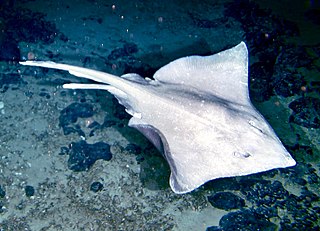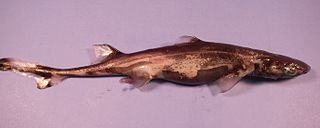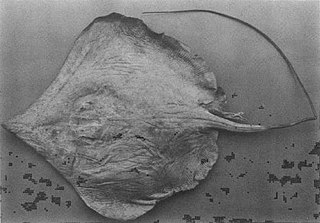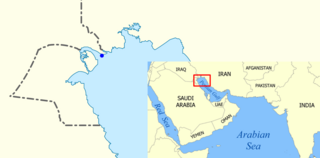
Rajiformes is one of the four orders in the superorder Batoidea, flattened cartilaginous fishes related to sharks. Rajiforms are distinguished by the presence of greatly enlarged pectoral fins, which reach as far forward as the sides of the head, with a generally flattened body. The undulatory pectoral fin motion diagnostic to this taxon is known as rajiform locomotion. The eyes and spiracles are located on the upper surface of the head and the gill slits are on the underside of the body. Most species give birth to live young, although some lay eggs enclosed in a horny capsule.

Richardson's ray is a skate of the family Arhynchobatidae, found in the Atlantic Ocean and around Cook Strait in New Zealand, at depths of from 1,300 to 2,500 m. Their length can reach 1.75 m. Dorsal and ventral surfaces of the disc are uniformly covered with dermal denticles, but lack thorns on the disc. The tail has 18 moderately sized thorns.

The green lanternshark is a species of dogfish shark in the family Etmopteridae, found in the western central Atlantic Ocean. This species usually occurs on the upper continental slope below a depth of 350 m (1,150 ft). Reaching 26 cm (10 in) in length, the green lanternshark has a slender body with a long, thin tail and low, conical dermal denticles on its flanks. It is dark brown or gray with ventral black coloration, which contain light-emitting photophores that may serve a cryptic and/or social function. Green lanternsharks are thought to be gregarious and may attack their prey, squid and octopus often larger than themselves, in packs. Reproduction is aplacental viviparous, with females giving birth to litters of one to three young. This relatively common shark is an occasional, valueless bycatch of commercial fisheries; currently it does not appear to be significantly threatened by human activities.

Bathyraja is a large genus of skates in the family Arhynchobatidae.

The deepsea skate is a species of softnose skate, in the family Arhynchobatidae, found in deep water from 362 to 2,906 m, usually on the continental slope. They are distributed from off northern Baja California around Coronado Island and Cortes Bank, north to the Bering Sea, and west to Japan. There have also been sightings north of Darwin Island within the Galapagos Marine Reserve in 2015. This was the first record of the Deepsea Skate being found in the tropical eastern Pacific Ocean. It is fairly common below 1,000 m, and is taken as bycatch in deepwater trawls and traps. The species name abyssicola comes from the Greek abyssos meaning "bottomless", and cola meaning "living at depths".

The sharpnose stingray is a little-known species of stingray in the family Dasyatidae, found off southern Japan and in the East China Sea. With a rounded pectoral fin disc and a long, projecting snout, T. acutirostra resembles the smaller pale-edged stingray. A number of characteristics differentiate this species from D. zugei, including larger eyes and the absence of a dorsal fin fold on the tail. The International Union for Conservation of Nature (IUCN) has assessed this species as Near Threatened, as its restricted distribution renders it vulnerable to increases in fishing pressure.

The Mekong freshwater stingray, Hemitrygon laosensis, is a species of stingray in the family Dasyatidae, restricted to the Mekong and Chao Phraya Rivers in Laos and Thailand; the occurrence in Chao Phraya is considered an introduction. Measuring up to 62 cm (24 in) across, this ray has an oval pectoral fin disc, a tail with both upper and lower fin folds, and a midline row of spine-like dermal denticles. A characteristic feature of this species is its bright orange underside. The Mekong freshwater stingray preys on invertebrates and is aplacental viviparous. It has been assessed as Endangered by the International Union for Conservation of Nature (IUCN), as it is threatened by overfishing and habitat degradation.

The Florida torpedo is a rare and little-known species of electric ray in the family Torpedinidae. It is known only from two specimens and a some wild sightings. Torpedoes have been recorded from three scattered locations in the Florida Straits and the western Caribbean Sea, and appear to inhabit coral habitats.
Bathyraja maculata, the white-blotched skate, is a species of skate from the western North Pacific Ocean. An adult is approximately 1 meter in length, and is found at depths of up to 1 kilometer. Unlike any other known member of the genus Bathyraja, the white-blotched skate has white blotches on a grey to brown dorsal surface, while the ventral side is lighter in color with darker blotches. Dorsal side is rough with spines, while the ventral side is smooth.

The Tumbes round stingray is a little-known species of round ray, family Urolophidae, known only from two immature male specimens collected from estuarine waters at depths of 1–2 m, and a third specimen collected in 2006 near mangroves. Its range appears to be limited to coastal waters off Tumbes in northern Peru, where it is found partially buried in sand or mud. The larger of the original two specimens measured 40.4 cm long and the smaller 15.7 cm.

The Pacific white skate is a species of skate in the family Arhynchobatidae. It is one of the deepest-living of all skates, occurring at a depth of 800 to 2,938 m on the continental slope. It is native to the southeast Pacific Ocean from the Galapagos Islands to off Waldport, Oregon; an egg case and embryo has been collected from the Farallon Islands off San Francisco. Reports of it from the Sea of Okhotsk may represent a different species. Its species name, spinosissima, comes from the Latin spinosus meaning "thorny", referring to its covering of dermal denticles.

Bathyraja mariposa, sometimes referred to as the butterfly skate, is a species of skate found in the Aleutian islands. It is overall a medium-brown color, lacks thorns on the disc and has indistinct thorns on the tail. It was discovered in 2002 during a National Marine Fisheries Service survey, and first described in 2004. The holotype specimen is held at the University of Washington. Its species name "mariposa" derives from the Spanish word for butterfly, although several other species are sometimes referred to as the "butterfly skate."
The roughnose stingray is a little-known species of stingray in the family Dasyatidae, generally found in shallow, estuarine waters associated with mangroves off Borneo, Sumatra, and possibly Java. Growing to 72 cm (28 in) across, this species has a rhomboid pectoral fin disc and a whip-like tail with a ventral fin fold. It is characterized by its pointed snout, which is covered by dermal denticles. Reproduction is aplacental viviparous, with females possibly bearing as few as one pup at a time. The International Union for Conservation of Nature (IUCN) has assessed the roughnose stingray as Endangered; it is threatened by overfishing and the destruction and degradation of its mangrove habitat.
The phallic catshark is a little-known species of catshark, belonging to the family Scyliorhinidae. It is found on or near the ocean floor, in the deep waters off New Caledonia and Vanuatu. A slender species attaining a length of 46 cm (18 in), it is characterized by a long caudal fin bearing a crest of enlarged dermal denticles along the dorsal margin, and very long claspers in adult males. This shark is gray-colored, with four dark saddles along the back and tail.
The Peruvian skate is a large skate found in the southeast Pacific Ocean, off the coasts of Peru, Ecuador, and Chile. It can grow to an estimated 1.1 metres total length, and 1.25 m across. It is known to be a deepwater species; the holotype was caught at a depth of 908 m (2,979 ft), and is generally found at depths of 600–1,100 m (2,000–3,600 ft). Very little is known about its biology.

The graytail skate, or gray tail skate, is a large species of skate in the family Arhynchobatidae, native to the south-western Atlantic Ocean and south-eastern Pacific Ocean. It is listed as endangered by the IUCN. It was caught as part of a commercial fishery around the Falkland Islands and is a bycatch in several other fisheries.

The pita skate is a medium-sized skate in the family Rajidae. The holotype and only known specimen was found in the northern Persian Gulf, in Iraqi waters. It was collected at a depth of less than 15 m (49 ft).
Bathyraja panthera, the leopard skate, is a species of cartilaginous fish in the family Arhynchobatidae. It was first described as a new species in 2011, having been discovered in the Aleutian Islands at depths between 50 to 258 m. It is a moderately large species with a short snout and wide mouth. The dorsal surface is pale greenish-brown, with speckling, round black spots and yellow blotches, giving it its specific name panthera from its resemblance to a leopard skin. It is an egg-bearing species, the eggs being enclosed in egg capsules with horns at the corners.

The Ningaloo maskray is a species of stingray in the family Dasyatidae, found along the northwestern coast of Australia. Measuring up to 30 cm (12 in) across, it has a diamond-shaped pectoral fin disc with a blunt snout and rounded outer corners. Its tail is whip-like with both upper and lower fin folds. This species has a distinctive dorsal color pattern consisting of numerous small, sharp-edged deep orange spots and slightly larger, fuzzy-edged pale blue spots on a yellowish brown background.
The longnose deep-sea skate is a large skate in the family Arhynchobatidae. It was first described in 1985 from specimens collected near New Zealand. It is known to be a deep-water skate, however lack of research trawls at depths past 1500 meters limits knowledge of the depths where the species can be found. The species is dark brown or grey, with an eponymous elongated snout. The species has been measured to be a maximum of 140 cm in total length, although size variation and growth patterns are not known.













